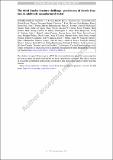| dc.description.abstract | Abstract
The Sandia Fracture Challenges provide a forum for the mechanics community to assess its ability to predict ductile fracture through a blind, round-robin format where mechanicians are challenged to predict the deformation and failure of an arbitrary geometry given experimental calibration data. The Third Challenge (SFC3) required participants to predict fracture in an additively manufactured (AM) 316L stainless steel bar containing through holes and internal cavities that could not have been conventionally machined. The volunteer participants were provided extensive data including tension and notched tensions tests of 316L specimens built on the same build-plate as the Challenge geometry, micro-CT scans of the Challenge specimens and geometric measurements of the feature based on the scans, electron backscatter diffraction (EBSD) information on grain texture, and post-test fractography of the calibration specimens. Surprisingly, the global behavior of the SFC3 geometry specimens had modest variability despite being made of AM metal, with all of the SFC3 geometry specimens failing under the same failure mode. This is attributed to the large stress concentrations from the holes overwhelming the stochastic local influence of the AM voids and surface roughness. The teams were asked to predict a number of quantities of interest in the response based on global and local measures that were compared to experimental data, based partly on Digital Image Correlation (DIC) measurements of surface displacements and strains, including predictions of variability in the resulting fracture response, as the basis for assessment of the predictive capabilities of the modeling and simulation strategies. Twenty-one teams submitted predictions obtained from a variety of methods: the finite element method (FEM) or the mesh-free, peridynamic method; solvers with explicit time integration, implicit time integration, or quasi-statics; fracture methods including element deletion, peridynamics with bond damage, XFEM, damage (stiffness degradation), and adaptive remeshing. These predictions utilized many different material models: plasticity models including J2 plasticity or Hill yield with isotropic hardening, mixed Swift-Voce hardening, kinematic hardening, or custom hardening curves; fracture criteria including GTN model, Hosford-Coulomb, triaxiality-dependent strain, critical fracture energy, damage-based model, critical void volume fraction, and Johnson-Cook model; and damage evolution models including damage accumulation and evolution, crack band model, fracture energy, displacement value threshold, incremental stress triaxiality, Cocks-Ashby void growth, and void nucleation, growth, and coalescence. Teams used various combinations of calibration data from tensile specimens, the notched tensile specimens, and literature data. A detailed comparison of results based of these different methods is presented in this paper to suggest a set of best practices for modeling ductile fracture in situations like the SFC3 AM-material problem. All blind predictions identified the nominal crack path and initiation location correctly. The SFC3 participants generally fared better in their global predictions of deformation and failure than the participants in the previous Challenges, suggesting the relative maturity of the models used and adoption of best practices from previous Challenges. This paper provides detailed analyses of the results, including discussion of the utility of the provided data, challenges of the experimental-numerical comparison, defects in the AM material, and human factors. | en_US |
